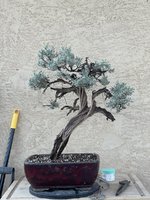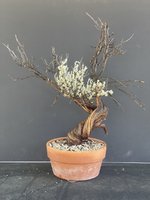Repotted this one today. The entire nursery can was full of roots. Problem is, the root system was entirely one sided. When I put this one in a pot, it had little no roots on it. I thought for sure it would die. So when I potted it up I did it very quickly and just packed in pumice.
Survive it did and then some. It quickly shaped up to be as good an example of a sagebrush bonsai as I had seen. It took some doing to get this thing wired in tight, but it is sure snug.
While I have intentions for a custom pot long term I figured this pot suited its look quite well for now. I trimmed the tree back significantly as it was so overgrown and even grew quite a bit over winter.
I was also able to apply a good amount of wire on the brittle branches placing pads and branching where it is needed long term.
The smaller branches were easily moved, the larger ones needed to be wrapped with wet paper towels for a time to allow moving. Once the tree recovers I expect some great images
View attachment 480086View attachment 480087
View attachment 480088
View attachment 480090


















